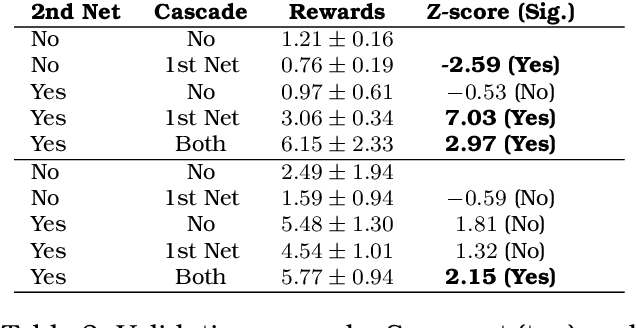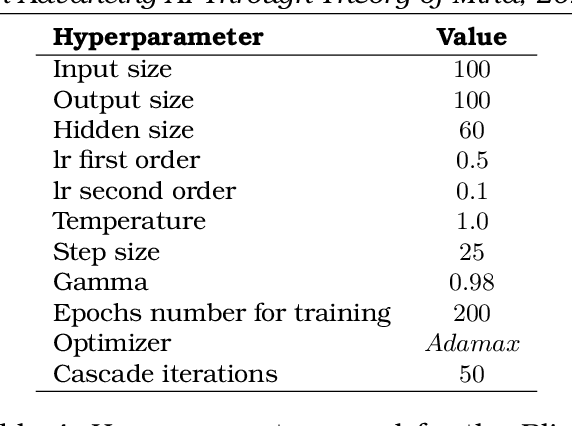Sonia Chernova
PARSEC: Preference Adaptation for Robotic Object Rearrangement from Scene Context
May 16, 2025Abstract:Object rearrangement is a key task for household robots requiring personalization without explicit instructions, meaningful object placement in environments occupied with objects, and generalization to unseen objects and new environments. To facilitate research addressing these challenges, we introduce PARSEC, an object rearrangement benchmark for learning user organizational preferences from observed scene context to place objects in a partially arranged environment. PARSEC is built upon a novel dataset of 110K rearrangement examples crowdsourced from 72 users, featuring 93 object categories and 15 environments. We also propose ContextSortLM, an LLM-based rearrangement model that places objects in partially arranged environments by adapting to user preferences from prior and current scene context while accounting for multiple valid placements. We evaluate ContextSortLM and existing personalized rearrangement approaches on the PARSEC benchmark and complement these findings with a crowdsourced evaluation of 108 online raters ranking model predictions based on alignment with user preferences. Our results indicate that personalized rearrangement models leveraging multiple scene context sources perform better than models relying on a single context source. Moreover, ContextSortLM outperforms other models in placing objects to replicate the target user's arrangement and ranks among the top two in all three environment categories, as rated by online evaluators. Importantly, our evaluation highlights challenges associated with modeling environment semantics across different environment categories and provides recommendations for future work.
Proceedings of 1st Workshop on Advancing Artificial Intelligence through Theory of Mind
Apr 28, 2025



Abstract:This volume includes a selection of papers presented at the Workshop on Advancing Artificial Intelligence through Theory of Mind held at AAAI 2025 in Philadelphia US on 3rd March 2025. The purpose of this volume is to provide an open access and curated anthology for the ToM and AI research community.
ADAPT: Actively Discovering and Adapting to Preferences for any Task
Apr 05, 2025Abstract:Assistive agents should be able to perform under-specified long-horizon tasks while respecting user preferences. We introduce Actively Discovering and Adapting to Preferences for any Task (ADAPT) -- a benchmark designed to evaluate agents' ability to adhere to user preferences across various household tasks through active questioning. Next, we propose Reflection-DPO, a novel training approach for adapting large language models (LLMs) to the task of active questioning. Reflection-DPO finetunes a 'student' LLM to follow the actions of a privileged 'teacher' LLM, and optionally ask a question to gather necessary information to better predict the teacher action. We find that prior approaches that use state-of-the-art LLMs fail to sufficiently follow user preferences in ADAPT due to insufficient questioning and poor adherence to elicited preferences. In contrast, Reflection-DPO achieves a higher rate of satisfying user preferences, outperforming a zero-shot chain-of-thought baseline by 6.1% on unseen users.
Bi-Directional Mental Model Reconciliation for Human-Robot Interaction with Large Language Models
Mar 10, 2025Abstract:In human-robot interactions, human and robot agents maintain internal mental models of their environment, their shared task, and each other. The accuracy of these representations depends on each agent's ability to perform theory of mind, i.e. to understand the knowledge, preferences, and intentions of their teammate. When mental models diverge to the extent that it affects task execution, reconciliation becomes necessary to prevent the degradation of interaction. We propose a framework for bi-directional mental model reconciliation, leveraging large language models to facilitate alignment through semi-structured natural language dialogue. Our framework relaxes the assumption of prior model reconciliation work that either the human or robot agent begins with a correct model for the other agent to align to. Through our framework, both humans and robots are able to identify and communicate missing task-relevant context during interaction, iteratively progressing toward a shared mental model.
Robot Behavior Personalization from Sparse User Feedback
Oct 25, 2024



Abstract:As service robots become more general-purpose, they will need to adapt to their users' preferences over a large set of all possible tasks that they can perform. This includes preferences regarding which actions the users prefer to delegate to robots as opposed to doing themselves. Existing personalization approaches require task-specific data for each user. To handle diversity across all household tasks and users, and nuances in user preferences across tasks, we propose to learn a task adaptation function independently, which can be used in tandem with any universal robot policy to customize robot behavior. We create Task Adaptation using Abstract Concepts (TAACo) framework. TAACo can learn to predict the user's preferred manner of assistance with any given task, by mediating reasoning through a representation composed of abstract concepts built based on user feedback. TAACo can generalize to an open set of household tasks from small amount of user feedback and explain its inferences through intuitive concepts. We evaluate our model on a dataset we collected of 5 people's preferences, and show that TAACo outperforms GPT-4 by 16% and a rule-based system by 54%, on prediction accuracy, with 40 samples of user feedback.
CE-MRS: Contrastive Explanations for Multi-Robot Systems
Oct 10, 2024



Abstract:As the complexity of multi-robot systems grows to incorporate a greater number of robots, more complex tasks, and longer time horizons, the solutions to such problems often become too complex to be fully intelligible to human users. In this work, we introduce an approach for generating natural language explanations that justify the validity of the system's solution to the user, or else aid the user in correcting any errors that led to a suboptimal system solution. Toward this goal, we first contribute a generalizable formalism of contrastive explanations for multi-robot systems, and then introduce a holistic approach to generating contrastive explanations for multi-robot scenarios that selectively incorporates data from multi-robot task allocation, scheduling, and motion-planning to explain system behavior. Through user studies with human operators we demonstrate that our integrated contrastive explanation approach leads to significant improvements in user ability to identify and solve system errors, leading to significant improvements in overall multi-robot team performance.
* Accepted to IEEE Robotics and Automation Letters
Semantically-Driven Disambiguation for Human-Robot Interaction
Sep 25, 2024Abstract:Ambiguities are common in human-robot interaction, especially when a robot follows user instructions in a large collocated space. For instance, when the user asks the robot to find an object in a home environment, the object might be in several places depending on its varying semantic properties (e.g., a bowl can be in the kitchen cabinet or on the dining room table, depending on whether it is clean/dirty, full/empty and the other objects around it). Previous works on object semantics have predicted such relationships using one shot-inferences which are likely to fail for ambiguous or partially understood instructions. This paper focuses on this gap and suggests a semantically-driven disambiguation approach by utilizing follow-up clarifications to handle such uncertainties. To achieve this, we first obtain semantic knowledge embeddings, and then these embeddings are used to generate clarifying questions by following an iterative process. The evaluation of our method shows that our approach is model agnostic, i.e., applicable to different semantic embedding models, and follow-up clarifications improve the performance regardless of the embedding model. Additionally, our ablation studies show the significance of informative clarifications and iterative predictions to enhance system accuracies.
ConSOR: A Context-Aware Semantic Object Rearrangement Framework for Partially Arranged Scenes
Sep 30, 2023



Abstract:Object rearrangement is the problem of enabling a robot to identify the correct object placement in a complex environment. Prior work on object rearrangement has explored a diverse set of techniques for following user instructions to achieve some desired goal state. Logical predicates, images of the goal scene, and natural language descriptions have all been used to instruct a robot in how to arrange objects. In this work, we argue that burdening the user with specifying goal scenes is not necessary in partially-arranged environments, such as common household settings. Instead, we show that contextual cues from partially arranged scenes (i.e., the placement of some number of pre-arranged objects in the environment) provide sufficient context to enable robots to perform object rearrangement \textit{without any explicit user goal specification}. We introduce ConSOR, a Context-aware Semantic Object Rearrangement framework that utilizes contextual cues from a partially arranged initial state of the environment to complete the arrangement of new objects, without explicit goal specification from the user. We demonstrate that ConSOR strongly outperforms two baselines in generalizing to novel object arrangements and unseen object categories. The code and data can be found at https://github.com/kartikvrama/consor.
State2Explanation: Concept-Based Explanations to Benefit Agent Learning and User Understanding
Sep 21, 2023



Abstract:With more complex AI systems used by non-AI experts to complete daily tasks, there is an increasing effort to develop methods that produce explanations of AI decision making understandable by non-AI experts. Towards this effort, leveraging higher-level concepts and producing concept-based explanations have become a popular method. Most concept-based explanations have been developed for classification techniques, and we posit that the few existing methods for sequential decision making are limited in scope. In this work, we first contribute a desiderata for defining "concepts" in sequential decision making settings. Additionally, inspired by the Protege Effect which states explaining knowledge often reinforces one's self-learning, we explore the utility of concept-based explanations providing a dual benefit to the RL agent by improving agent learning rate, and to the end-user by improving end-user understanding of agent decision making. To this end, we contribute a unified framework, State2Explanation (S2E), that involves learning a joint embedding model between state-action pairs and concept-based explanations, and leveraging such learned model to both (1) inform reward shaping during an agent's training, and (2) provide explanations to end-users at deployment for improved task performance. Our experimental validations, in Connect 4 and Lunar Lander, demonstrate the success of S2E in providing a dual-benefit, successfully informing reward shaping and improving agent learning rate, as well as significantly improving end user task performance at deployment time.
Predicting Routine Object Usage for Proactive Robot Assistance
Sep 12, 2023Abstract:Proactivity in robot assistance refers to the robot's ability to anticipate user needs and perform assistive actions without explicit requests. This requires understanding user routines, predicting consistent activities, and actively seeking information to predict inconsistent behaviors. We propose SLaTe-PRO (Sequential Latent Temporal model for Predicting Routine Object usage), which improves upon prior state-of-the-art by combining object and user action information, and conditioning object usage predictions on past history. Additionally, we find some human behavior to be inherently stochastic and lacking in contextual cues that the robot can use for proactive assistance. To address such cases, we introduce an interactive query mechanism that can be used to ask queries about the user's intended activities and object use to improve prediction. We evaluate our approach on longitudinal data from three households, spanning 24 activity classes. SLaTe-PRO performance raises the F1 score metric to 0.57 without queries, and 0.60 with user queries, over a score of 0.43 from prior work. We additionally present a case study with a fully autonomous household robot.
 Add to Chrome
Add to Chrome Add to Firefox
Add to Firefox Add to Edge
Add to Edge